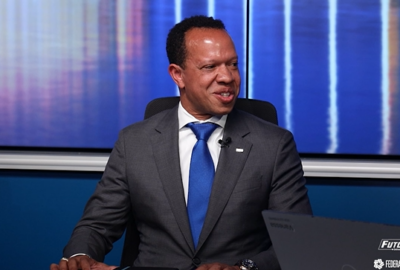What the Trump administration will mean for federal contractors
Federal contractors have more questions than answers when it comes to the incoming Trump administration, including what would a budget deal now look like.
Worried about Schedule F and the future of your job? Excited to see if DOGE can improve government efficiency? Want to know more about the proposed pick to head up your department? Federal News Network is tracking all things transition-related, as the 47th administration’s plans for the federal workforce take shape. Visit our Tracking the Transition page to keep up with the latest developments.
Federal contractors have more questions than answers when it comes to the incoming Trump administration. Among the top questions: What will a budget deal now look like? And what about 2026 now in preparation by the agencies? David Berteau, president and CEO of the Professional Services Council, joined the Federal Drive with Tom Temin to provide some insight.
Interview transcript:
Tom Temin: And these yo-yo back-and-forth pendulum politics are starting to be a little fatiguing, aren’t they, David?
David Berteau: Well, Tom, they certainly will rob your sleep if you’re not careful. They will eat into your evening and your morning. What a surprise to get an outcome as quickly as we did this week and a very decisive outcome it appears to be.
Tom Temin: Right. And so now the first order of business is because the country is on a continuing resolution. I guess maybe that’s the first question. What’s your sense of what a budget deal might look like or what could happen now?
David Berteau: Well, it is certainly a really critical question, not only for government contractors, but for all of their government customers. Right. Every agency, every program is in limbo right now. They’ve got a continuing resolution. It goes until the Friday before Christmas, December 20th. Congress, of course, will return this week, and they’ll have five weeks in session, two between now and Thanksgiving and three more after Thanksgiving before Christmas in order to resolve fiscal year 25 and see whether we get another continuing resolution or we can reach an agreement. We’ve got some history here. We had a similar situation in 2016, first time that Mr. Trump won and there was a deal. There was an agreement. They were ready to go. Congress would pass it. But you also had a situation where some in Congress wanted to delay the decision so that the Trump administration could get in place and put their imprint on it that year for fiscal year 2017, we didn’t end up with a full year appropriations until the 26th of April, which is more than halfway through the fiscal year. It’s certainly our hope in PSC and I think it’s probably the hope of all the programs in government that need to keep operating that we would reach agreement, Congress could reach agreement and finalize FY 25 and basically clear the decks for the Trump administration could start working afresh on the FY 26 budget.
Tom Temin: Right. Because in theory, the 26 submissions are due just a month or so after inauguration, but that’s unlikely at this point.
David Berteau: Again, looking at history, it doesn’t happen very often in the change of administrations. That hasn’t happened since really 2000, 2008 really, which is the last time that we actually had appropriations before the election. I think, though, that the other dynamic here is the Biden administration is certainly working hard to build their FY 26 budget. the fiscal guidance is out there. Every agency has built their budget, they’ve submitted it to OMB or reviewed it, etc. But that’s not likely to ever be finalized. That will be put on the shelf now and Trump team will come in and make their changes to that. So agencies, when we look at the programs in the agencies, they’ve got uncertainty, right? They don’t know what they’re going to get for fiscal year 25. They don’t know when they’re going to get it. They know what they’ve asked for FY 26, but they don’t know what will be in the final budget. So that’s really three layers of uncertainty there, how much you’re going to get when you’re going to get it and what is the following year look like? In many ways, you actually can’t put FY 26 to bed until you know what you got in FY 25. So not only do you have these three uncertainties, but there’s a dependency inside there. What this typically does in the government contracting space is it slows everything down because if you don’t know how much you’re going to get, you hang on to what you have now a little tighter. You disperse those funds, obligate those funds a little more slowly. And I think that’s something that every government contractor should be prepared for over the coming months. We’ll have to see what happens between now and Dec. 20 as to whether we make it easier or harder going forward.
Tom Temin: Right. And besides that uncertainty of just the budgetary process, there’s also the uncertainty over policy. And some of the policy components have a big effect on budgets for agencies. If you’re going to have this initiative, it’s going to cost this much if the new administration wants to quash that initiative and so on and so on. And that might even be a bigger uncertainty.
David Berteau: Well, you’re right. There again are three layers of that uncertainty. Probably the top layer is what’s the cap going to look like? Again, going back in history in 2016, again in 2020, after that election, you still had the Budget Control Act caps in place. So those caps were in statutorily in there for both defense and in the aggregate for non-defense or civilian agencies, as we refer to them. We’ve got a cap right now for fiscal year 25. It’s the Fiscal Responsibility Act that was part of the debt ceiling deal back just a year-and-a half ago. But there’s no agreement on what the numbers would be for FY 26. So that’s kind of the biggest policy level issue, is how much money and how is it divided between defense and non-defense? Then there’s the question of whatever’s in 25 and what would be in 26 is either a continuation of what was there before or perhaps a change to something new. Scale back on something going on, kill something altogether. Those are the policy-level issues that I think from our perspective, it would benefit the government to focus on 26 and what you want to start new what you want to scale back on or shut down altogether rather than try to go backwards and get rid of things that are already in the past. That’s a complicated layer.
Tom Temin: We’re speaking with David Berteau, president and CEO of the Professional Services Council. And on the non-budgetary issue, there’s a lot of federal acquisition regulation rules that are in the final or proposed stage. And I guess those would all be under review now, too.
David Berteau: You’re right. Here again, there’s a couple of options available. And looking back at history, again, we look at 2016 and 2017, it does appear we don’t know the finality right now, but it does appear that Republicans will not only have a majority in the Senate, but they may likely retain their majority, although a very slim majority in the House of Representatives. So with what we call unified government, that is the same party in the White House and with the majority in both houses of Congress, you have the option of using the Congressional Review Act covered that a number of times on your show over the years. And looking back at history again, in 2017, Congress enacted about 16 or 17 reversals of previous administration rules and policies under the Congressional Review Act, only a couple of those directly affected government contracting. But that’s certainly a possibility. There could be some undoing of rules that are already in place, but fit within the time limits of the Review Act along the way. In addition, of course, the incoming administration talked about having a number of executive orders ready to go on Day One. We haven’t seen those, but we can anticipate that some of those executive orders will reverse or alter executive orders from the previous administration. And we’ll have to see how that happens. But when there’s already a rule in place and it’s outside the time limits of using the Congressional Review Act, then undoing that rule will actually require following the Administrative Procedure Act. You’ll have to propose to cancel the rule or change the rule. You have to go through either an interim rule or a proposed rule and go through the comment period and adjudicate those comments. So that will take some time. PSC, of course, has a number of rules that were implemented under the Biden administration and we would like to see altered or reversed that really inhibit the ability of contractors to deliver the kind of mission support that the government needs.
Tom Temin: Right. There is one big rule, though, and one just became finalized in the second part of it is in the proposal stage concerning the CMMC program at DoD, the Cybersecurity Maturity Model certification program. If I recall, that started initially under the last Trump administration.
David Berteau: You’re right. In fact, the CMMC 1.0, it’s referred to, was the first Defense Federal Acquisition Regulation Supplement (DFARS) rule because this is not a governmentwide rule that applies only to DoD. So it’s a defense for our supplement of the DFARS was issued in late 2020, but it didn’t really take effect. It wasn’t going into contract. It was available, but it hadn’t yet gone into contracts because they were still working out the process to be certified that you would be compliant with that rule. And then it was undone at the beginning of the Biden administration and it took them essentially most of the four years of the administration to put out the revised rules. We did just get the basic part of that rule, which is what standards do you need to meet in order to be compliant? The second part of the rule is still under adjudication, and that’s how does it get into contracts? We could well see a situation where that again would be put in its tracks, although I haven’t seen any indication that the incoming administration intends to do that. Now, the big questions we raised there are a number of issues that are unclear in terms of how you implement that rule. And if you look actually at the final rule for what they call Part 32, that’s the code of federal regulations on national defense. That part says all your concerns, Mr. PSC, are legitimate, but they’re outside the scope of the rule-making process, so we’re not going to deal with it in the rule. Well, that doesn’t mean you don’t need to deal with them, Tom. It just means you have to find another avenue to deal with them. Things like what is controlled and classified information. How is the administration going to manage the demand for the level of security that you have to acquire? If everybody has to be at the top level? You’ll never be able to get there because you just won’t have the capacity or the money to make sure to pay for it. All those kinds of things are still very much up in the air.
Tom Temin: And a final question on return to office. I’m presuming that federal employees will be under a return to the office a lot more frequently than many of them are now under a Trump administration. We saw signs of that in the last Trump administration in the liberal telework ideas could be curtailed. That would have an impact possibly on contractors as well, correct?
David Berteau: Well, every contractor depends on a functioning office, both at the program level, at the budget level, and, of course, at the contracting officer level, both for new solicitations and for managing existing contracts. I think there’s been a difference agency-by agency and probably geography-by-geography in terms of who’s in the office. One of the challenges for our industry has been how do you meet with people when they’re not there to meet with you. And I think one thing we’ve all learned, Tom, is that while there’s plenty of good audio and video connectivity to virtual space, there’s still really no substitute for face-to-face in-person interaction. So we look forward to having the government back in the office and being able to meet with industry.
Copyright © 2024 Federal News Network. All rights reserved. This website is not intended for users located within the European Economic Area.
Tom Temin is host of the Federal Drive and has been providing insight on federal technology and management issues for more than 30 years.
Follow @tteminWFED






